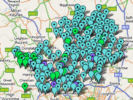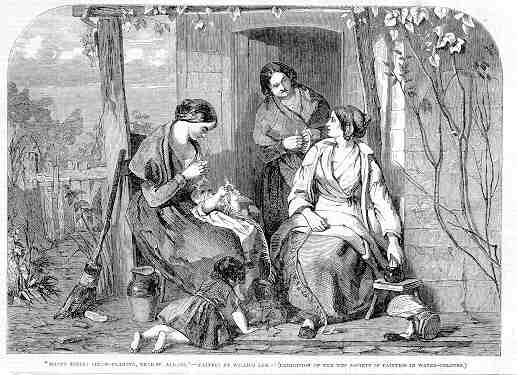|
The History of Straw Plait in Hertfordshire |
|
||||||||
|
From the unfinished draft of
a book
The first record of straw hats in England comes from a 13th century illustrated manuscript which shows harvest workers wearing such hats [REF 1]. While straw was used in local crafts at an earlier date, the art of straw plaiting is said to have been brought to the area by James the First of England in about 1600, when some plaiters from Lorraine came to England where they were sheltered by the Napier family of Luton Hoo [REF 2]. In 1667, Mrs Samuel Pepys, weary with a walk around Hatfield Park, found pleasure in trying on a straw hat [REF 3]. Tring was given a charter for a market on Fridays in 1680 by Charles II. The sales of straw plait were restricted to the morning, and the afternoon was reserved for corn [REF 4]. This would suggest that straw plait was already a very flourishing business in the area. |
For more about straw plaiting see The Economics of Straw Plaiting in 1801
~~~~ A few of the many pages with references to Straw, Straw Plait and Straw Hats Fraudulently dealing in Straw Plait, St Albans, 1882 Akeman Street & the West End, Tring The Plait Market, Hemel Hempstead Hertfordshire Industry in 1903 Agricultural Strike, Sandridge, 1873 ~~~~ Tring Local History Museum has a display showing tools used in making straw plait |
|||||||||||||||||||||||||||||||||||||||||||||||||
|
A Bill of 1689, a clause of which was designed to encourage
the wearing of woollen hats, drew forth protest from those occupying some 100
square miles in the north-west of the Chilterns, who declared that a thousand
families containing ‘fourteen thousand persons at least’ maintained
themselves by making straw hats [REF 5].
There was a further petition in 1719 [REF
6].
In 1724 Daniel Defoe comments on the spread of straw plaiting where it was already widespread, into Hertfordshire [REF 7]. The art was spreading rapidly and in 1735 Oldmixon [REF 8] recorded "That several thousand plaitters found profitable employment in Bedfordshire and Hertfordshire." and "I was told at [Hemel] Hempsted that £200 a week has been turn’d in a market day in straw hats only, which manufacture has thriv’d in those parts above 100 years." In the eighteenth and early nineteenth century London was undoubtedly the chief hat manufacturing centre, and the presence of the Herts/Beds plaiting area 20 to 30 miles away, close to Watling Street was probably an important factor, and it may well be that wheat straw grown on chalk was of better quality. Until about 1835 most of the plait was taken out of the area, but after this date most of it was used locally for the increasing hat and bonnet manufacture [REF 9]. The heyday came with the Napoleonic wars, when blockade and high import duties excluded foreign and especially Italian plait [REF 10]. At a time when the average Hertfordshire agricultural wage was between 10s and 12s a week, straw plaiting wives could earn appreciably more than their husbands and children’s contributions to the family income were considerable. ‘The farmers complain of it as doing mischief’, declares Arthur Young in his General View of the Agriculture of Hertfordshire (1804) [REF 11]. ‘for it makes the poor saucy and no servants can be procured or any field work done where this manufacture establishes itself.’ But he adds that 'good earnings are a most happy circumstance, which I wish to see universal’, again emphasising that ‘straw plaiting is of very great use to the poor and has had considerable effect in keeping down rates, which must be far more burthensome without it.’ The industry boomed during the middle of the 19th century, but fell away sharply towards the end of the century, as the following census figures [REF 12] show.
The end of the industry was foreshadowed when, in 1865, cheap foreign plait was imported from the far east and the industry was virtually extinct by the beginning of the twentieth century. The local hat and bonnet industry continued, and straw bonnets became less popular after the First World War [REF 13]. [REF 1] Pierpont Morgan Library, MSS 638, folio 17 v, reproduced in Charles Freeman, Luton and the Hat Industry, Luton Museum, 1953. [REF 2] Thomas George Austin, The Straw Plaiting and Straw Hat and Bonnet Trade, Luton, 1871. [REF 3] J. Davies, Straw Plait, Shire Publications, Princes Risborough, 1981. [REF 4] Victoria County History for Hertfordshire, Volume 2, p281. This is the earliest English reference to straw plait, as opposed to straw hats, quoted in in Charles Freeman, op. cit. [REF 5] J. Davies, op. cit. [REF 6] A map based on The case of the poor straw hat makers in the counties of Hertford, Bedford and Buckingham (1719) is included in C. M. Law, The Straw-plait and Straw-hat Industries of the South Midlands (A) Luton and the Hat Industry, published in The East Midland Geographer, volume 4, pages 329-341, 1968. Copy of first page of petition in L. L. Gróf, Children of Straw, Barracuda Books, Buckingham, 1987 [REF 7] Daniel Defore, Tour of the Whole Island of Great Britain (1724), quoted in W. Branch Johnson, Industrial Archaeology of Hertfordshire, David & Charles, 1970 [REF 8] J. Oldmixon, History of England, 1735, quoted by Thomas George Austin, op. cit., and Charles Freeman, op. cit. [REF 9] C.M. Law, op. cit. He quotes a range of other sources on this subject. [REF 10] W. Branch Johnson, op. cit. [REF 11] Arthur Young, General View of the Agriculture of Hertfordshire (1804) quoted in W. B. Johnson, op. cit. [REF 12] L. L. Gróf, op. cit. [REF 13] C.M. Law, op. cit. |
||||||||||||||||||||||||||||||||||||||||||||||||||



